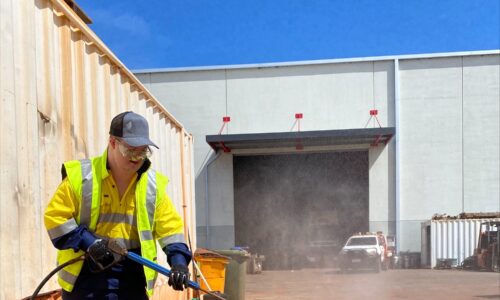Ranger Exploration Drilling develops an automated RC Drill Rig
Our company, Ranger Exploration Drilling (Ranger), partnered with two Western Australian businesses to innovate on drill rig design and manufacture through the inclusion of technologies being applied across the mining industry.

Our company holds progressive attitudes and values to improvement on work practices, and equipment as on all our key values. Seeing the development of equipment, particularly automation in mining as well as general equipment, increased our curiosity in this area.
A reverse circulation drill was the target, with a reduction of human input into the operation of the machine. Our partners in the project, Western Drill Maintenance and Compliance (WDM) and Cortex Intelligence Systems (Cortex) have built significant expertise in this area through previous experience and projects. So, as expected, they stepped up to the plate and took on the challenge.
WDM took on the mechanical engineering and build of the machine, with Cortex developing the control systems. We had previously developed, in partnership with Cortex, MDP system that is fitted onto our rigs. The MDP is made up of Monitor While Drilling (MWD) equipment, as well as systems that provide remote monitoring of equipment on a live basis. We run dashboards in our head office where we can see the status of all rigs, production statistics, hole depths and activities (amongst other things). From this system, the development of automation onto the drill became a natural progression.
Thus, the design brief was to utilize automated control, where possible, to improve the operating reliability, consistency and reduce the need for human input into repetitive operating tasks.
The drill
The result is an RC drill rig with the ability to set itself up on angle, handle single and multiple rod handling cycles, with additional functionality available to fully automate as the programming maturity develops – including RC bit changes, sampling and eventually auto drilling.
Whilst automation has been incorporated into exploration machines by other businesses, WDM and Cortex are among the first (that we are aware of) to commercialize an exploration machine of this nature.
The base design was approached to enable the retro fitment of the automated components to a range of currently available RC machines.
The rigs are capable of remote monitoring, including cameras for eyes on the task. The Cortex MDP systems are fitted to capture the operating parameters of the machine including, but not limited to:
- head position;
- feed rate;
- time drilling;
- time rod handling;
- hole depth, rod count;
- daily meter production;
- rotation speed and torque;
- holdback/pulldown pressure.

Testing
Once the first drill design and manufacture were completed, we hit a quarry near Perth, Australia, for field testing. The testing program went well, there were issues, but mainly with some programming and communication dropouts. These were quickly identified and rectified. The rig structure and functions performed well, with no major rework required. The machine spent around three weeks in the quarry before mobilization to a contract and an operating site.
On-site work presented a few more development challenges. We were fortunate to locate the rig at a site where mobile network communications (3G/4G) were available, making it easier for the tech team to remote into the control systems for monitoring and to update things as required. The learning curve for our drillers was the most interesting. They picked up the operating system of the machine very well – certainly, there were some challenges, frustrations and long phone calls, but to their credit, they hung in there and spent time understanding stuff they haven’t dealt with before.
Automation is a funny thing. From my perspective, it all depends on what I call ‘knowing’. If an autonomous device knows where it is, it knows where everything else is. Therefore, it knows where it needs to go… makes sense? A couple of early learning frustrations for the drillers related to things shifting slightly out of adjustment or home position, meant the machine wouldn’t move, as it couldn’t confirm the location of something. The drillers adapted well once they understood some of the basic principles and were able to assist the technicians, who were remoting into the drill.
Aside from highlighting the efforts of our drillers, the client was a great support. Any innovation comes with risk – safety, production and so on. Without clients like ours, these projects would never get off the ground. Our client was willing to support through input, assistance and bear the costs for low production and testing during the early times. I suppose ultimately, they see the long-term benefits and will reap those rewards as they manifest.
Early results
The automated functions have seen improvements in the following tasks/areas:
- manning on the machine has been reduced as rod handling now only requires the driller;
- sampling duties have become more fluent, as no rod handling operations are carried out by the offsiders;
- the consistency and fluency of the rod handling equipment reduces wear of components – the machine is a smoother operator than a person;
- damage through poor operating practices has been reduced.
Prior to field testing, Ranger reached out to some of our key drillers – people we knew had the motivation to challenge themselves and have a go with this type of equipment. It is funny, at first, they were all a bit standoffish. Roll forward a bit of time and they have adjusted well and enjoy operating a little further away from the machine. Some of them bring their ‘tunes’ to work now and place their personal speakers on the control module for entertainment.
The improvements listed above are the obvious ones. We are seeing other benefits to our staff – no more standing next to the drill hole area with its dust, noise and potential for projectiles. The vibration emanating from the drill stands is gone – people are more alert and less fatigued
We have two of these machines operating in the field, with a third under build. For those who would question reliability and productivity, the following metrics have been taken year-to-date (YTD) against rigs operating under the same contracts, same geology and region:
Automated drill rigs – 8044 m (26 391 ft) and 7611 m (24 970 ft)
Conventional drill rigs – 9498 m (31 161 ft), 7682 m (25 203 ft), 7544 m (24 751 ft)
Not a lot of difference, and in some cases an improvement.


A little more about the machine
| Model | WDMES270 |
| Rig Type | Exploration – RC |
| Control System | Smart – Remote Control |
| Compressor Capacity | 1250 cfm/500 psi @1800 RPM |
| Engine Model | Cat C27 ACERT DITA |
| Pullback | 27 tonne (60 000 lbs) |

